 |
 |
Our enthusiastic and extremely knowledgeable perennials team is here to answer your questions and help you choose the best perennials for your situation. There’s always something in bloom for sun, shade, butterflies, birds or deer resistance as well as a variety of bulbs for your space.
Stroll through our time-tested favorites and introduce yourself to the newest varieties. We garden with perennials too; we love them and it shows!
|
32 found, showing page 2 of 3
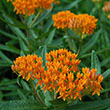
Plant Height: 24 inches
Flower Height: 32 inches
Spread: 24 inches
Sunlight: full sun
Hardiness Zone: 2b
Description:
A wonderful selection that is perfect for attracting butterflies to gardens; bright golden orange clusters of fragrant flowers rise above narrow, green foliage during the summer months and into early fall; easy to grow, drought tolerant once established
Ornamental Features:
Butterfly Weed has fragrant orange flat-top flowers with gold overtones at the ends of the stems from mid to late summer. The flowers are excellent for cutting. Its narrow leaves remain green in color throughout the season.
Landscape Attributes:
Butterfly Weed is an herbaceous perennial with an upright spreading habit of growth. Its medium texture blends into the garden, but can always be balanced by a couple of finer or coarser plants for an effective composition.
This is a relatively low maintenance plant, and is best cleaned up in early spring before it resumes active growth for the season. It is a good choice for attracting butterflies to your yard, but is not particularly attractive to deer who tend to leave it alone in favor of tastier treats. It has no significant negative characteristics.
Butterfly Weed is recommended for the following landscape applications:
- Mass Planting
- General Garden Use
- Naturalizing And Woodland Gardens
Planting & Growing:
Butterfly Weed will grow to be about 24 inches tall at maturity extending to 32 inches tall with the flowers, with a spread of 24 inches. It tends to be leggy, with a typical clearance of 1 foot from the ground, and should be underplanted with lower-growing perennials. It grows at a medium rate, and under ideal conditions can be expected to live for approximately 10 years. As an herbaceous perennial, this plant will usually die back to the crown each winter, and will regrow from the base each spring. Be careful not to disturb the crown in late winter when it may not be readily seen!
This plant should only be grown in full sunlight. It is very adaptable to both dry and moist locations, and should do just fine under typical garden conditions. It is considered to be drought-tolerant, and thus makes an ideal choice for a low-water garden or xeriscape application. It is not particular as to soil type or pH. It is quite intolerant of urban pollution, therefore inner city or urban streetside plantings are best avoided. This species is native to parts of North America.
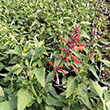
Fragrant mounding foliage with coral-pink flowers. Long bloomer. Heat & humidity tolerant. USDA 5-10
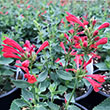
Dwarf cultivar with fragrant foliage and bright red blooms. USDA 6-10
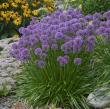
Compact, upright clump of glossy green leaves. Clusters of bright purple flowers blooms in mid-summer. USDA 4-8
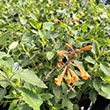
Fragrant, tidy foliage with upright habit and tangarine orange colored flowers. Tolerates Deer & Wet Soils. USDA 5-10
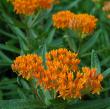
This monarch host plant produces orange blooms in summer. Tolerates drought, poor soils, & deer. Native. USDA 3-9
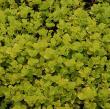
Yellow blooms. Gold-green foliage. Moderate foot traffic. USDA 4-8
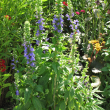
Tall spikes of blue blooms. Tolerates moist to wet soils. Native. USDA 4-9
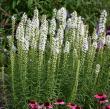
Fluffy, white flowers attract pollinators. Upright, strong stalks. USDA 3-9
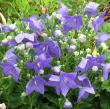
Flower buds puff up like balloons before bursting open into blue bell-shaped flowers. Compact. USDA 3-9
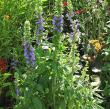
Tall spikes of blue blooms. Tolerates moist to wet soils. Native. USDA 4-9
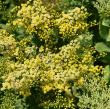
Yellow blooms. Upright foliage. Compact habit. Clump-Forming. USDA 5-8
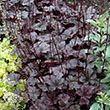
Plant Height: 6 inches
Flower Height: 12 inches
Spacing: 10 inches
Sunlight: full sun, partial shade, full shade
Hardiness Zone: 4a
Other Names: Coralbells, Alumroot
Description:
Beautiful plum-purple foliage with silvery overtones create tight mounds, perfect for beds, borders, containers and rock gardens; creamy white flower spikes contrast against dark and moody foliage; flowers are suitable for cutting
Ornamental Features:
Plum Pudding Coral Bells features dainty spikes of creamy white bell-shaped flowers rising above the foliage from late spring to early summer. Its attractive crinkled lobed leaves remain purple in color with distinctive deep purple veins and tinges of silver throughout the year.
Landscape Attributes:
Plum Pudding Coral Bells is a dense herbaceous evergreen perennial with tall flower stalks held atop a low mound of foliage. Its relatively fine texture sets it apart from other garden plants with less refined foliage.
This is a relatively low maintenance plant, and should be cut back in late fall in preparation for winter. It is a good choice for attracting hummingbirds to your yard. It has no significant negative characteristics.
Plum Pudding Coral Bells is recommended for the following landscape applications:
- Mass Planting
- Rock/Alpine Gardens
- Border Edging
- General Garden Use
- Groundcover
- Container Planting
- Planting & Growing
Plum Pudding Coral Bells will grow to be only 6 inches tall at maturity extending to 12 inches tall with the flowers, with a spread of 12 inches. When grown in masses or used as a bedding plant, individual plants should be spaced approximately 10 inches apart. Its foliage tends to remain low and dense right to the ground. It grows at a medium rate, and under ideal conditions can be expected to live for approximately 10 years. As an evegreen perennial, this plant will typically keep its form and foliage year-round.
This plant performs well in both full sun and full shade. However, you may want to keep it away from hot, dry locations that receive direct afternoon sun or which get reflected sunlight, such as against the south side of a white wall. It prefers to grow in average to moist conditions, and shouldn't be allowed to dry out. It is not particular as to soil type or pH. It is somewhat tolerant of urban pollution. Consider covering it with a thick layer of mulch in winter to protect it in exposed locations or colder microclimates. This particular variety is an interspecific hybrid. It can be propagated by division; however, as a cultivated variety, be aware that it may be subject to certain restrictions or prohibitions on propagation.
Plum Pudding Coral Bells is a fine choice for the garden, but it is also a good selection for planting in outdoor pots and containers. It is often used as a 'filler' in the 'spiller-thriller-filler' container combination, providing a mass of flowers and foliage against which the larger thriller plants stand out. Note that when growing plants in outdoor containers and baskets, they may require more frequent waterings than they would in the yard or garden.
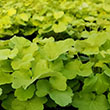
Plant Height: 6 inches
Flower Height: 12 inches
Spacing: 12 inches
Sunlight: full sun, partial shade, full shade
Hardiness Zone: 4a
Other Names: Coralbells, Alumroot
Description:
Dainty spikes of cream colored bells rise from a compact mound of bright lemon foliage with silvery undersides; foliage is more chartreuse in denser shade; amazing contrast to other plants; great versatility; keep soil moist in the heat of summer
Ornamental Features:
Citronelle Coral Bells features dainty spikes of creamy white bell-shaped flowers rising above the foliage from late spring to mid summer. Its attractive crinkled lobed leaves remain lemon yellow in color with curious silver undersides throughout the year.
Landscape Attributes:
Citronelle Coral Bells is a dense herbaceous evergreen perennial with tall flower stalks held atop a low mound of foliage. Its relatively fine texture sets it apart from other garden plants with less refined foliage.
This is a relatively low maintenance plant, and should be cut back in late fall in preparation for winter. It is a good choice for attracting hummingbirds to your yard. It has no significant negative characteristics.
Citronelle Coral Bells is recommended for the following landscape applications:
- Mass Planting
- Rock/Alpine Gardens
- Border Edging
- General Garden Use
- Groundcover
- Container Planting
- Planting & Growing
Citronelle Coral Bells will grow to be only 6 inches tall at maturity extending to 12 inches tall with the flowers, with a spread of 15 inches. When grown in masses or used as a bedding plant, individual plants should be spaced approximately 12 inches apart. Its foliage tends to remain low and dense right to the ground. It grows at a medium rate, and under ideal conditions can be expected to live for approximately 10 years. As an evegreen perennial, this plant will typically keep its form and foliage year-round.
This plant performs well in both full sun and full shade. However, you may want to keep it away from hot, dry locations that receive direct afternoon sun or which get reflected sunlight, such as against the south side of a white wall. It prefers to grow in average to moist conditions, and shouldn't be allowed to dry out. It is not particular as to soil type or pH. It is somewhat tolerant of urban pollution. Consider covering it with a thick layer of mulch in winter to protect it in exposed locations or colder microclimates. This particular variety is an interspecific hybrid. It can be propagated by division; however, as a cultivated variety, be aware that it may be subject to certain restrictions or prohibitions on propagation.
Citronelle Coral Bells is a fine choice for the garden, but it is also a good selection for planting in outdoor pots and containers. It is often used as a 'filler' in the 'spiller-thriller-filler' container combination, providing a mass of flowers and foliage against which the larger thriller plants stand out. Note that when growing plants in outdoor containers and baskets, they may require more frequent waterings than they would in the yard or garden.
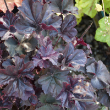
Plant Height: 10 inches
Flower Height: 24 inches
Spacing: 10 inches
Sunlight: full sun, partial shade, full shade
Hardiness Zone: 4a
Other Names: Coralbells, Alumroot
Description:
Dark and moody deep purple-black, smooth and shiny foliage wont fade in the sun; tall flower spikes of creamy white appear during the early summer; flowers are suitable for cutting; great for color contrast in beds, borders and containers; low maintenance
Ornamental Features:
Obsidian Coral Bells features dainty spikes of creamy white bell-shaped flowers rising above the foliage from late spring to early summer. Its attractive crinkled lobed leaves emerge burgundy in spring, turning black in color with curious deep purple undersides the rest of the year.
Landscape Attributes:
Obsidian Coral Bells is a dense herbaceous evergreen perennial with tall flower stalks held atop a low mound of foliage. Its relatively fine texture sets it apart from other garden plants with less refined foliage.
This is a relatively low maintenance plant, and should be cut back in late fall in preparation for winter. It is a good choice for attracting hummingbirds to your yard. It has no significant negative characteristics.
Obsidian Coral Bells is recommended for the following landscape applications:
- Mass Planting
- Rock/Alpine Gardens
- Border Edging
- General Garden Use
- Groundcover
- Container Planting
- Planting & Growing
Obsidian Coral Bells will grow to be about 10 inches tall at maturity extending to 24 inches tall with the flowers, with a spread of 12 inches. When grown in masses or used as a bedding plant, individual plants should be spaced approximately 10 inches apart. Its foliage tends to remain low and dense right to the ground. It grows at a medium rate, and under ideal conditions can be expected to live for approximately 10 years. As an evegreen perennial, this plant will typically keep its form and foliage year-round.
This plant performs well in both full sun and full shade. However, you may want to keep it away from hot, dry locations that receive direct afternoon sun or which get reflected sunlight, such as against the south side of a white wall. It prefers to grow in average to moist conditions, and shouldn't be allowed to dry out. It is not particular as to soil type or pH. It is somewhat tolerant of urban pollution. Consider covering it with a thick layer of mulch in winter to protect it in exposed locations or colder microclimates. This particular variety is an interspecific hybrid. It can be propagated by division; however, as a cultivated variety, be aware that it may be subject to certain restrictions or prohibitions on propagation.
Obsidian Coral Bells is a fine choice for the garden, but it is also a good selection for planting in outdoor pots and containers. With its upright habit of growth, it is best suited for use as a 'thriller' in the 'spiller-thriller-filler' container combination; plant it near the center of the pot, surrounded by smaller plants and those that spill over the edges. Note that when growing plants in outdoor containers and baskets, they may require more frequent waterings than they would in the yard or garden.
32 found, showing page 2 of 3







